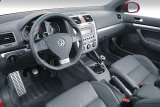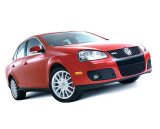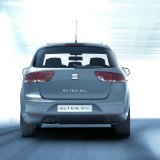New Porsche 911 Turbo
Highlights
For the first time the power unit of the new Porsche 911 Turbo features an exhaust gas turbocharger with variable turbine geometry (VTG) for efficient control of the exhaust gas flow throughout the entire range of engine speed, guiding the flow of air in exactly the right direction and at the right angle to the turbine blades. The result is yet a further increase in engine output, despite engine capacity remaining unchanged at 3.6 litres, from 309 kW (420 bhp) to 353 kW (480 bhp). Maximum torque, in turn, is up from 560 to 620 Newton-metres (383 to 457 lb-ft) and starts at a very low 1950 rpm.
New four-wheel-drive managementBenefiting from a newly developed four-wheel-drive management system, the 911 Turbo is able to convert the enormous power of the engine into practical performance on the road with optimum traction in every situation: PTM Porsche Traction Management features an electromagnetically controlled multiple-plate clutch for optimum distribution of power front-to-rear. Responding within fractions of a second to both driving and road conditions, PTM is able to immediately transmit more power to the front wheels whenever required.
Fast with six-speed manual, even faster with Tiptronic S
This extra power and torque naturally means an even higher standard of dynamic performance on the road: Equipped with a six-speed manual gearbox, the new 911 Turbo accelerates to 100 km/h in 3.9 seconds. And featuring optional Tiptronic S, the car completes the same sprint even faster in just 3.7 seconds. This makes the new 911 Turbo the first sports car from Porsche with even faster acceleration in the automatic mode than in manual – a result of the interaction of the turbochargers with their variable turbine geometry, Porsche Traction Management, and the new Tiptronic S set-up.
Extra power: Sports Chrono Package Turbo with OverboostFor the first time the optional Sports Chrono Package Turbo provides a brief Overboost of power: Turbocharger pressure is increased to an even higher level in this mode, boosting torque by 60 Newton-metres to a staggering 680 Nm or 501 lb-ft. This Overboost is naturally a great advantage in short, interim acceleration and overtaking manoeuvres.
Active suspension featured as standardThe new top-end model in the 911 model range comes as standard with PASM Porsche Active Suspension Management giving the driver the choice of either a sporting but comfortable standard set-up (Normal mode) or a particularly sporting and dynamic set-up (Sports mode).
Even more efficient brake system
Reflecting truly outstanding performance, the new 911 Turbo features a brake system even more efficient than on the former model. Indeed, the brake concept on the front wheels has been carried over from the Carrera GT, with six-piston brake callipers in conjunction with 350-millimetre (13.78") brake discs ensuring supreme stopping power.
The new brake configuration also feeds more brake power to the rear wheels, where four-piston brake callipers again interact with brake discs measuring 350 millimetres in diameter.
Two other features are pre-loading of the brake system and the Brake Assistant both serving to shorten stopping distances even further when applying the brakes all-out.
The new 911 Turbo is also available as an option with PCCB Porsche Ceramic Composite Brakes for truly outstanding brake qualities ensured by ceramic brake discs now developed to an even higher standard and even larger in their dimensions than before.
Tiptronic S with new dynamic driving functionsWhenever the driver takes his foot off the gas pedal abruptly, the Fast-Off function now also prevents the Tiptronic transmission from shifting up even if the driver does not release the gas pedal completely. This improves driving dynamics to an even higher standard, particularly on winding roads and serpentines.
The new, additional Fast-Back function, in turn, enables the driver to shift down more quickly when applying the brakes in a sporting style and moving over quickly from the gas to the brake pedal. When braking into a bend, for example, Fast-Back automatically helps to find the right gear for subsequently accelerating dynamically out of the bend.
Very high standard of passive safety
Like the entire 911 model series, the new top-of-the-range 911 Turbo offers a supreme standard of passive safety: Apart from full-size airbags for the driver and front passenger, the entire range of six airbags includes two head airbags in the side window sills interacting in a side-on collision with thorax airbags in the front seat backrests in a combination offered worldwide by Porsche as the very first manufacturer.
Reversing the weight spiralDespite the change in dimensions and new functions, the new 911 Turbo is lighter than its predecessor – a significant benefit also ensured by the doors made completely of aluminium. Weighing just 11 kilos or 24 lb, the doors, together with other lightweight features, help to give the car a DIN unladen weight of 1585 kg or 3495 lb. The power-to-weight ratio, in turn, is an outstanding 4.49 kg per kW or 3.3 kg per horsepower.
Porsche 911 Turbo
Innovative Technology for Supreme Driving
Offering a truly cutting-edge package of new, innovative technology features, the new Porsche 911 Turbo sets an unprecedented benchmark in driving dynamics. The key elements of this package are the two turbochargers for the first time featuring variable turbine geometry (VTG) as well as Porsche's newly developed and fully controlled four-wheel-drive PTM Porsche Traction Management.
Interacting efficiently with one another, these two systems offer the driver a new world of performance even more dynamic performance than before: Accelerating all-out with an optimum six-speed manual gearshift, the new 911 Turbo reaches 100 km/h in just 3.9 seconds and hits the 160 km/h-mark within 8.4 seconds. And even this is not all, since the combination of new turbocharger technology and Porsche Traction Management with the newly set-up Tiptronic S makes the car's acceleration even faster: Fitted with optional Tiptronic transmission, the new 911 Turbo accelerates to 100 km/h in a staggering 3.7 seconds. Top speed with both types of transmission, finally, is 310 km/h or 192 mph.
Dynamic looksThe new 911 Turbo comes right at the top of the 911 model series not only on account of its supreme performance. The exterior design of the car is also a lot more sporting and dynamic than that of the former model, at the same time clearly revealing that this top-performance athlete is a full member of the new 911 Series: Strikingly chiselled intake air scoops with integrated LED direction indicators and foglamps moved far to the outside give the front end a unique, characteristic look. The rear end, in turn, now exudes an even more distinctive impression of power thanks to the wheel arches widened by 22 millimetres or 0.87" and the tailpipes moved higher up than before. The side air intakes behind the doors have also been re-designed, again contributing to the special character of the 911 Turbo.
Significant progress in technology: turbocharger with variable turbine geometry
The supreme performance of the car is attributable in particular to the newly developed turbocharger technology boasted on the six-cylinder power unit: Using special materials extremely resistant to high temperatures, Porsche's engineers have succeeded in developing an exhaust gas turbocharger with variable turbine geometry (VTG) able to withstand very high exhaust gas temperatures of up to 1000° C or 1830° F also on a gasoline engine. So now one turbocharger with variable turbine geometry offers the advantages of both a small and a large turbocharger all in one. In practice, this means that the two turbines featured for the first time as a team are able to use exhaust energy at all times and under all operating conditions for an optimum boost effect.
The result of this new technology is a significant increase in both power and torque: Maximum output of the flat-six power unit is now 353 kW (480 bhp) at 6000 rpm, 44 kW or 60 bhp more than on the former model – and this is despite engine capacity remaining unchanged at exactly 3.6 litres. Peak torque, in turn, is up from 560 to 620 Newton-metres (413 – 457 lb-ft) throughout a far wider speed range, the new Turbo maintaining its peak torque consistently all the way between 1950 and 5000 rpm and showing a much better response than an engine with a conventional turbocharger.
Overboost for even faster accelerationAs an option the new 911 Turbo is available with the Sports Chrono Package Turbo including Overboost as one of its special features for even faster acceleration: Pressing the Sports button, the driver is able to boost turbocharger pressure in the medium speed range briefly by approximately 0.2 bar, increasing torque by another 60 to 680 Newton-metres or 501 lb-ft in the interest of even faster acceleration and extra flexibility. In this case the 911 Turbo accelerates from 80 – 120 km/h (50 – 75 mph) in its second-highest gear in just 3.5 instead of 3.8 seconds (manual) or, respectively, in an even more impressive 3.3 instead of 3.5 seconds (Tiptronic S).
New all-wheel-drive management in a Porsche sports carThe new 911 Turbo combines more torque and more power with a significant improvement of power transmission ensured by new management of the car's four-wheel drive: Featured as standard, PTM Porsche Traction Management combines driving pleasure typical of Porsche offered by the engine mounted at the rear and rear-wheel drive with even greater driving stability, traction, and agile handling. To achieve this superiority, PTM transmits exactly the right percentage of engine power to the front wheels in each situation via an electromagnetically controlled multiple-plate clutch. Operating within 100 milliseconds at the very most, PTM responds more quickly than the engine to a change in load and more quickly than even the driver himself will ever notice. It is fair to say, therefore, that Porsche four-wheel drive is able to literally "look ahead". On the road this means superior agility on narrow country lanes, excellent traction and a high standard of all-round safety even in extreme driving manoeuvres at high speeds and on wet or snow-bound surfaces.
Safe driving dynamics with PSM and an optional limited-slip differential
In the new 911 Turbo PTM Porsche Traction Management communicates directly with PSM Porsche Stability Management also featured as standard. A further important benefit is that Stability Management is now supplemented by enhanced brake functions, pre-loading of the brake system serving to further shorten stopping distances when applying the brakes all-out. And should the driver apply the brakes quickly, but not with full force, the Brake Assistant is activated and the hydraulic pump serves to build up full brake pressure for ABS brake action on all four wheels. As an option, Porsche also offers the genuine enthusiast a mechanical rear axle wheel lock with asymmetric distribution of engine power further enhancing the driving dynamics of the fully controlled Porsche Traction Management all-wheel-drive system.
Active damper system for individual adjustment of the car's driving characteristicsEquipped with PASM Porsche Active Suspension Management, the new 911 Turbo comes as standard with yet another active control system for an even higher level of driving dynamics. This computer-based damper system benefits from direct interaction of PTM and PSM, with control functions matched even more closely to the car's driving dynamics. The driver has the choice of the Normal and Sports mode, with continuous damper adjustment being either more comfort-oriented or extra sporting and firm, depending on the setting chosen. In a nutshell, therefore, the new 911 Turbo adjusts in its driving behaviour to the driver's individual wishes and preferences.
Superior brake performance with optional ceramic brakesFollowing Porsche's straightforward safety philosophy, an increase in engine power always requires an appropriate increase in brake power. Precisely this is why the front wheels now come with six-piston fixed-calliper brakes increasing the brake lining area by no less than 42 per cent. Diameter of the inner-vented brake discs has also increased from 330 to 350 millimetres (13.00 – 13.78").
In this process of upgrading the brake system, Porsche's engineers have also given the rear wheel brakes more power, again increasing the size of the brake components: The brake discs at the rear now also measure 350 millimetres in diameter and interact with four-piston fixed callipers.
Like all models in the 911 series, the new Turbo is naturally available as an option with PCCB Porsche Ceramic Composite Brakes. Enhanced to an even higher standard and featuring brake discs at the front measuring no less than 380 millimetres or 14.96" in diameter, this supreme brake system offers an even faster response, fading-free qualities of the highest standard, and complete avoidance of any corrosion. And last but certainly not least, PCCB brakes are approximately 17 kg or 37 lb lighter than the brake system with grey cast iron brake discs.
Very good drag coefficientBoasting its new tailor-made suit, the 911 Turbo also offers excellent aerodynamics. Despite the wider body, the greater intake of cooling air, and 19-inch wheels, the drag coefficient remains unchanged at a Cd factor of just 0.31. At the same time Porsche's engineers have further reduced lift forces on the front axle and have once again increased downforces at the rear, above all as a result of the extending, newly contoured split wing above the engine compartment lid. Even at top speed, therefore, the driver enjoys all the benefits of a high-performance sports car with safe driving characteristics, superior driving stability, and clear-cut, easily calculable reactions.
New aluminium doors for less weightYet a further special feature on the new 911 Turbo is the doors now made of aluminium, over and above the light-alloy front lid. Thanks to a special production technique, the doors offer the same safety in a collision as the steel doors on the Carrera models. But at the same time they weigh just 11 kilos or 24 lb, reducing the weight of the car in all by 14 kilos or 31 lb. So with its unladen weight of 1585 kg (3495 lb), the new Turbo, despite a wider range of equipment, is 5 kg lighter than its predecessor.
Wide range of sophisticated features inside the carThe interior of the new 911 Turbo has been fully renewed and features leather upholstery and trim as standard, based on the interior design of the current generation of the 911 Carrera. The instruments with their aluminium-coloured faces come in Porsche's characteristic 911 design boasting the name "Turbo" in the rev counter.
White light-emitting diodes make the faces of the instruments even brighter at night, and for the first time turbocharger pressure is also shown as a bar diagram in the display in the round central instrument. And last but certainly not least, the car's new interior design features a gearshift lever in special Porsche Turbo look.
Like its predecessor, the new 911 Turbo comes as standard with PCM Porsche Communication Management including a DVD navigation module. The new BOSE Surround Sound System comprising no less than 13 loudspeakers and a seven-channel digital amplifier replaces the former BOSE Sound System. As an option, PCM may be further upgraded through the addition of a telephone module and an electronic logbook.
Further features coming as standard on the new 911 Turbo include rear-view mirrors with an automatic anti-dazzle function and a theft warning system monitoring the car by way of radar sensors both in the interior and with contact surveillance on the outer skin.











